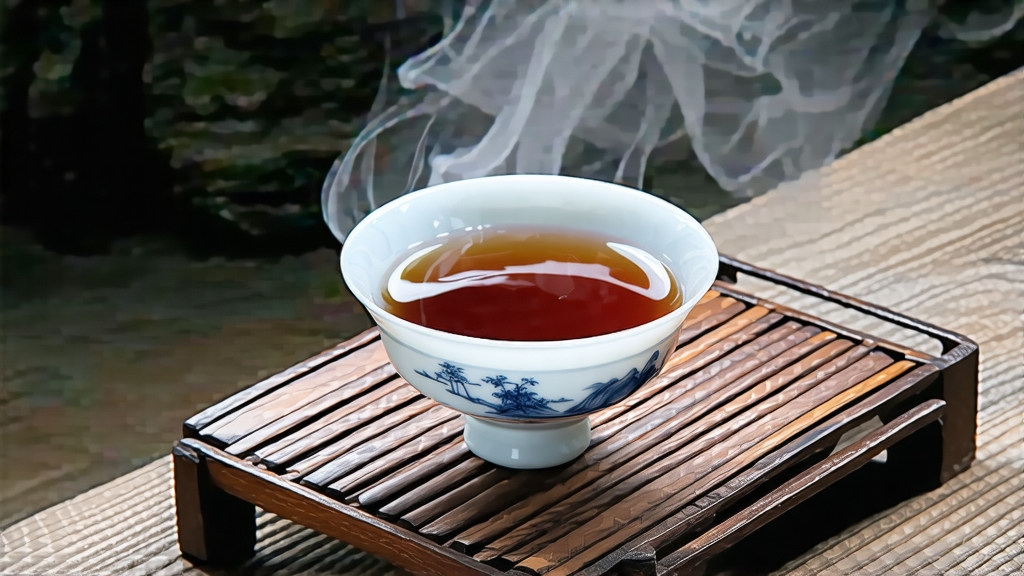
High in the Wuyi Mountains of northern Fujian, where the Nine-Bend River coils like a dragon’s tail through granite cliffs, grows a tea that poets once compared to “drinking liquid jade incense.” Locals call it Shui Xian—literally “Water Sprite”—a name that hints at the tea’s power to slip past the tongue and haunt the mind. First recorded in the late Ming dynasty (c. 1600 CE), Shui Xian is today the most widely produced oolong in Wuyi, yet it remains the benchmark against which all other “rock teas” (yancha) are judged. Its story is one of Buddhist monks, smuggled cuttings, imperial tax ledgers, and the slow alchemy of fire, stone, and time.
From myth to cultivar
Legend claims that a Ningde farmer named Zhu found a lone tea tree growing beside a well whose water smelled perpetually of flowers. After brewing the leaves, he dreamed of a celestial being who called the plant “Shui Xian,” then vanished into the mist. Zhu took cuttings, transplanted them into Wuyi’s Zheng Yan core region, and the cultivar thrived in the mineral soil. Genetic studies now show Shui Xian is a distinct, sexually propagated landrace rather than a grafted clone, which explains its broad genetic stability and the subtle field-to-field variations that connoisseurs prize.
Terroir: the cliff gardens
Wuyi’s UNESCO-listed heritage park contains three concentric zones—Zheng Yan (true cliff), Ban Yan (half cliff), and Zhou Cha (river terrace). Only 60 square kilometres of Zheng Yan enjoy the perfect triad of mist-shrouded mornings, afternoon sun on weathered tuff, and nightly temperature drops that force the leaves to thicken their cell walls, concentrating aromatic oils. The soil is so porous that rainwater disappears within minutes, prompting roots to dive three metres in search of aquifers laced with potassium and rare earth elements. These stresses create the celebrated “yanyun” (rock-essence)—a tactile minerality that feels like licking wet slate, followed by a lingering coolness Chinese tasters describe as “the returning rock rhyme.”
Craft: the eight stages of rock transformation
- Picking: only the middle three leaves are plucked when the morning dew has lifted but before the sun turns the edges red. Standard yield: 4 kg of fresh leaves for 1 kg of finished tea.
- Wilting: leaves are spread on bamboo screens in a shaded corridor; every 20 minutes they are gently tossed to bruise the margins, initiating oxidation.
- Shaking: the most athletic step. Two 3-metre-long bamboo trays are rocked in opposing arcs so the leaves rattle against each other, rupturing cells and releasing jasmine-like aldehydes. Masters listen for a rustle that sounds like “rain on silk.”
- Fixing: a 250 °C wok roast lasting 90 seconds halts oxidation at roughly 30 %, preserving the green core while caramelising the rim.
- Rolling: the hot leaves are wrapped in cloth bundles and rolled underfoot into tight braids that resemble black snakes.
- Initial baking: charcoal embers at 80 °C dry the leaf to 20 % moisture; the tea is now called mao cha.
- Sorting: stems and yellow leaves are removed by hand; the remaining leaf rests in earthen jars for one month to “calm the fire.”
- Final charcoal bake: using the secretive “low-fire long-bake” technique, the tea spends 8–12 hours above a pit of Wuyi fir charcoal whose temperature never exceeds 60 °C. Masters sprinkle water on the ash to create aromatic smoke that imparts a whisper of smoked lychee. The cycle may be repeated three times over three months, deepening the amber liquor and rounding the edges.
Styles: from floral to “old fir”
Shui Xian exists on a spectrum of roast. “Light-fire” versions, fashionable in coastal China, retain jade-green centres and release notes of white narcissus, honeydew, and fresh cream. “Medium-fire” teas show copper leaves and a liquor tasting of roasted almond, longan, and brown sugar. The connoisseur’s holy grail is “Lao Cong Shui X